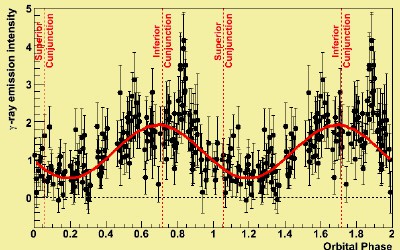The first astronomical source of very high-energy gamma-ray pulses has been discovered by an international team of researchers. The gamma rays, which have energies greater than 100 giga electron volts (GeV), are at least 100 000 times more energetic than other known periodic signals. (Astronomy & Astrophysics in press).

The pulses are produced in binary star system called LS 5039, which is a well-known source of x-rays. Located in the constellation Scutum, LS 5039 comprises a massive “blue” star that is about 20 times larger than the Sun and an unknown compact object that could be a black hole or neutron star. The two objects are locked in a highly eccentric orbit (see figure “Orbiting objects”).
The gamma-ray signal is periodic, repeating every 3.9 days, which is the time that it takes the compact object to complete one orbit of the star. The signal is strongest when the compact object is between the star and Earth and weakest when it is behind the star (see figure “Oscillating gamma rays”). The researchers believe that the signal is low when the compact object is behind the star because the gamma rays are being absorbed by light from the star.
The discovery was made using the High Energy Stereoscopic System (HESS) array of telescopes in Namibia. HESS focuses on the short flashes of blue light called Cerenkov radiation that are produced when the gamma rays interact with Earth’s atmosphere. This light is collected by four telescopes and is used to create images of astronomical objects as they appear in the gamma-ray region of the electromagnetic spectrum.
Gamma rays with energies greater than 1011 eV (100 GeV) are very rare indeed. On Earth they can only be produced in leading-edge particle accelerators such as the Tevatron at Fermilab. Extraterrestrial sources are thought to include supernovae, pulsars and quasars but these gamma rays only interact with the Earth’s atmosphere at a rate of about one event per month per square metre of atmosphere.
The researchers believe that the LS 5039 gamma rays are produced by the violent interaction of the compact object with the stellar wind, which is a plasma of charged particles that flows from the blue star at supersonic speeds. Some of these particles are accelerated to TeV (1012 eV) energies as they near the compact object and produce gamma rays by processes that are not yet fully understood. The researchers hope to get a better understanding of these processes by studying how the average energy of the gamma rays changes as the compact object moves through its orbit.
The team now plans to try and pierce through the star’s “photon fog”, which absorbs the gamma rays and so weakens the signal received on Earth. “We will then be able to directly see the particle acceleration mechanism at work,” explained HESS team member Guillaume Dubus from the Astrophysical Laboratory of Grenoble in France.




